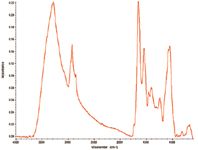Rapid Screening in Microbiology by FT-IR
Application Notebook
Yeast suspensions were dried and analyzed via FT-IR using an automated transmission sampling accessory. Up to six-fold sampling capacity increase may be realized through automation.
Yeast suspensions were dried and analyzed via FT-IR using an automated transmission sampling accessory. Up to six-fold sampling capacity increase may be realized through automation.
FT-IR spectroscopy has been shown to be an effective tool to classify bacteria, yeast, and fungi at the strain, species, and genus level. Compared to traditional microbiological techniques, IR sampling is less time-consuming. Microbiological applications for FT-IR analysis include a rapid method of identification and screening, quality control for food and pharmaceutical fields, and assessment of growth environment on cell and cell byproduct physiology.
An IR plate-reader for biological samples is desirable for laboratories confronted with high-throughput demands, and the need to save resources through automation. This application note illustrates the use of an in-compartment XY plate reader to analyze yeast and discusses the resource savings involved through accessory automation.
Experimental Conditions
Yeast suspensions (30 µL) were pipetted onto a sample well of a 96-well reusable Si plate, and dried at 45 °C for 1 h for subsequent infrared transmission measurements. The 96-well Si plate was loaded into the PIKE Technologies XY Autosampler Accessory, an FT-IR sample compartment automated transmission/diffuse reflection accessory. The spectral range spanned from 4000 to 600 cm-1 using a resolution of 4 cm-1 . Data collection time was 1 min. For transmission measurements the accessory's integrated DTGS detector is used to maximize the signal-to-noise ratio. Automated plate movement to each sample position is controlled by PIKE AutoPRO software, which also triggers data collection via the FT-IR spectrometer.
Results
Figure 1 shows a typical transmission spectrum of the dried yeast suspension. Some main spectral features include the C-H stretching vibrations from fatty acids between 3100–2800 cm-1 , the amide I and amide II bands between 1800–1500 cm-1 , and C-O-C and C-O-P stretching vibrations of polysaccharides between 1200–900 cm-1 . A comprehensive list of absorption band assignments may be found in Naumann (1). Application of multivariate analysis allows differentiation between unique biological materials (2,3).

Figure 1: Infrared transmission spectrum of dried yeast suspension.
Through automation the number of IR samples analyzed per day may be greatly enhanced and potential sample and data entry errors decreased. Due to variability in biological materials, replicate sample measurements are often required. If four replicate measurements are made for one sample, 84 samples may be analyzed in a typical eight-hour work day. This equates to over 330 individual spectra collected without end user input, except to load the 96-well plates once the process is started by the AutoPRO software.
In addition to biological applications, an automated XY plate reader may be used for polymer solutions and solvent residuals analysis.
Conclusions
Infrared transmission spectra of microbiological suspensions may be collected by drying the suspension on an IR transparent plate. The use of an in-compartment XY plate reader accessory provides means for automated measurements via transmission or reflectance to increase laboratory capacity.
References
(1) D. Naumann, Encyclopedia of Analytical Chemistry, R.A. Myers, Ed. 102–131 (2000).
(2) D. Naumann, Mikrochim Acta. 373–377 (1988).
(3) G. Fischer et al., J. Microbio.l Methods 63–77 (2006).
PIKE Technologies
6125 Cottonwood Drive, Madison, WI 53719
tel. (608) 274-2721, fax (608) 274-0103
Website: www.piketech.com

Thermo Fisher Scientists Highlight the Latest Advances in Process Monitoring with Raman Spectroscopy
April 1st 2025In this exclusive Spectroscopy interview, John Richmond and Tom Dearing of Thermo Fisher Scientific discuss the company’s Raman technology and the latest trends for process monitoring across various applications.
A Seamless Trace Elemental Analysis Prescription for Quality Pharmaceuticals
March 31st 2025Quality assurance and quality control (QA/QC) are essential in pharmaceutical manufacturing to ensure compliance with standards like United States Pharmacopoeia <232> and ICH Q3D, as well as FDA regulations. Reliable and user-friendly testing solutions help QA/QC labs deliver precise trace elemental analyses while meeting throughput demands and data security requirements.